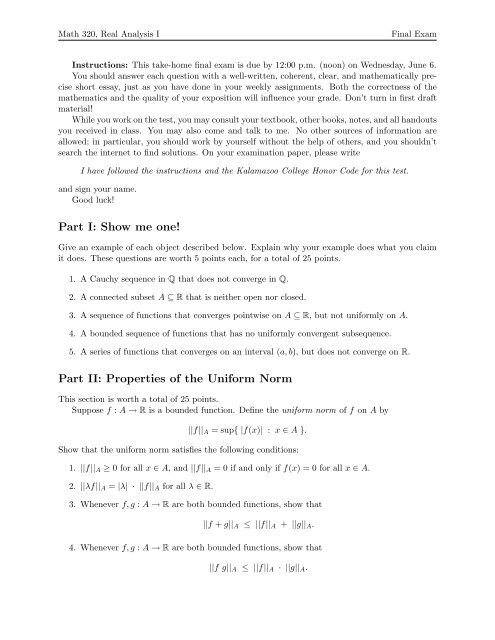Final Exam - Kalamazoo College
Final Exam - Kalamazoo College
Final Exam - Kalamazoo College
You also want an ePaper? Increase the reach of your titles
YUMPU automatically turns print PDFs into web optimized ePapers that Google loves.
Math 320, Real Analysis I<br />
<strong>Final</strong> <strong>Exam</strong><br />
Instructions: This take-home final exam is due by 12:00 p.m. (noon) on Wednesday, June 6.<br />
You should answer each question with a well-written, coherent, clear, and mathematically precise<br />
short essay, just as you have done in your weekly assignments. Both the correctness of the<br />
mathematics and the quality of your exposition will influence your grade. Don’t turn in first draft<br />
material!<br />
While you work on the test, you may consult your textbook, other books, notes, and all handouts<br />
you received in class. You may also come and talk to me. No other sources of information are<br />
allowed; in particular, you should work by yourself without the help of others, and you shouldn’t<br />
search the internet to find solutions. On your examination paper, please write<br />
I have followed the instructions and the <strong>Kalamazoo</strong> <strong>College</strong> Honor Code for this test.<br />
and sign your name.<br />
Good luck!<br />
Part I: Show me one!<br />
Give an example of each object described below. Explain why your example does what you claim<br />
it does. These questions are worth 5 points each, for a total of 25 points.<br />
1. A Cauchy sequence in Q that does not converge in Q.<br />
2. A connected subset A ⊆ R that is neither open nor closed.<br />
3. A sequence of functions that converges pointwise on A ⊆ R, but not uniformly on A.<br />
4. A bounded sequence of functions that has no uniformly convergent subsequence.<br />
5. A series of functions that converges on an interval (a, b), but does not converge on R.<br />
Part II: Properties of the Uniform Norm<br />
This section is worth a total of 25 points.<br />
Suppose f : A → R is a bounded function. Define the uniform norm of f on A by<br />
||f|| A = sup{ |f(x)| : x ∈ A }.<br />
Show that the uniform norm satisfies the following conditions:<br />
1. ||f|| A ≥ 0 for all x ∈ A, and ||f|| A = 0 if and only if f(x) = 0 for all x ∈ A.<br />
2. ||λf|| A = |λ| · ||f|| A for all λ ∈ R.<br />
3. Whenever f, g : A → R are both bounded functions, show that<br />
||f + g|| A ≤ ||f|| A + ||g|| A .<br />
4. Whenever f, g : A → R are both bounded functions, show that<br />
||f g|| A ≤ ||f|| A · ||g|| A .
Math 320, Real Analysis I<br />
<strong>Final</strong> <strong>Exam</strong><br />
Part III: Taylor Series and Lagrange’s Remainder Theorem<br />
These questions are worth 10 points each, for a total of 30 points.<br />
Let f be infinitely differentiable on the interval (−R, R). Define a n = f (n) (0)<br />
n!<br />
let<br />
S N (x) = a 0 + a 1 x + a 2 x 2 + · · · + a N x N .<br />
for each n, and<br />
The polynomial S N (x) is a partial sum of the Taylor series expansion for the function f(x). Define<br />
E N (x) = f(x) − S N (x)<br />
which represents the error between f and the partial sum S N . Clearly proving S N (x) → f(x) is<br />
equivalent to showing E N (x) → 0.<br />
1. Explain why the error function E N (x) = f(x) − S N (x) satisfies<br />
for all n = 0, 1, 2, . . . , N.<br />
E (n)<br />
N (0) = 0<br />
2. Assume x > 0 and consider the functions E N (x) and x N+1 on the interval [0, x]. Show that<br />
there exists a point x 1 ∈ (0, x) such that<br />
E N (x)<br />
x N+1 = E′ N (x 1)<br />
(N + 1)x N 1<br />
3. Prove Lagrange’s Remainder Theorem, which states:<br />
Let f be infinitely differentiable on (−R, R), define a n = f (n) (0)/n!, and let<br />
S N (x) = a 0 + a 1 x + a 2 x 2 + · · · + a N x N .<br />
Given x ≠ 0, there exists a point c satisfying |c| < |x| where the error function<br />
E N (x) = f(x) − S N (x) satisfies<br />
.<br />
E N (x) = f (N+1) (c)<br />
(N + 1)!<br />
x N+1 .<br />
Part IV: Arzelà-Ascoli Theorem<br />
Question 1 is worth 5 points while the remaining questions are 10 points each, so this section is<br />
worth a total of 45 points.<br />
Recall the Bolzano-Weierstrass Theorem (Theorem 2.5.5) states that every bounded sequence<br />
of real numbers has a convergent subsequence. An analogous statement for bounded sequences<br />
of functions is not true in general. (See Part I, Problem 4.) Under stronger hypotheses,<br />
however, we can derive a Bolzano-Weierstrass Theorem for sequences of functions. First, we make<br />
the following definition:<br />
A sequence of functions (f n ) defined on a set E ⊆ R is called equicontinuous if for every<br />
ε > 0 there exists a δ > 0 such that<br />
for all n ∈ N and |x − y| < δ in E.<br />
|f n (x) − f n (y)| < ε
Math 320, Real Analysis I<br />
<strong>Final</strong> <strong>Exam</strong><br />
With this definition now in hand, answer the following question.<br />
1. What is the difference between saying that a sequence of functions (f n ) is equicontinuous and<br />
just asserting that each f n in the sequence is individually uniformly continuous?<br />
For each n ∈ N, let f n be a function defined on [0, 1]. If (f n ) is bounded on [0, 1] — that<br />
is, there exists an M > 0 such that |f n (x)| ≤ M for all n ∈ N and all x ∈ [0, 1] — and if<br />
the collection of functions (f n ) is equicontinuous, follow these steps to show that (f n ) contains a<br />
uniformly convergent subsequence.<br />
2. By Exercise 6.2.14, there exists a subsequence (f nk ) that converges at every rational point in<br />
[0, 1]. To simplify notation, set g k = f nk .<br />
IGNORE THE REST OF THIS PROBLEM! It is a typo, as it is only asking you<br />
to do problems 3, 4 and 5 below. I’ll give each of you the 10 points from this<br />
problem “for free” when grading the exam.<br />
Show that (g k ) converges uniformly on all of [0, 1].<br />
3. Let ε > 0. By equicontinuity, there exists a δ > 0 such that<br />
|g k (x) − g k (y)| < ε 3<br />
for all |x − y| < δ and k ∈ N. Using this δ, show that there is a finite collection of rational<br />
points r 1 , r 2 , . . . , r m ∈ [0, 1] with the property that the union of the neighborhoods V δ (r i )<br />
contains [0, 1].<br />
4. Explain why there must exist an N ∈ N such that<br />
|g s (r i ) − g t (r i )| < ε 3<br />
for all s, t ≥ N and r i in the finite subset of [0, 1] described above.<br />
Why does having the set {r 1 , r 2 , . . . , r m } be finite matter?<br />
5. Finish the argument by showing that, for an arbitrary x ∈ [0, 1],<br />
|g s (x) − g t (x)| < ε<br />
for all s, t ≥ N.
















